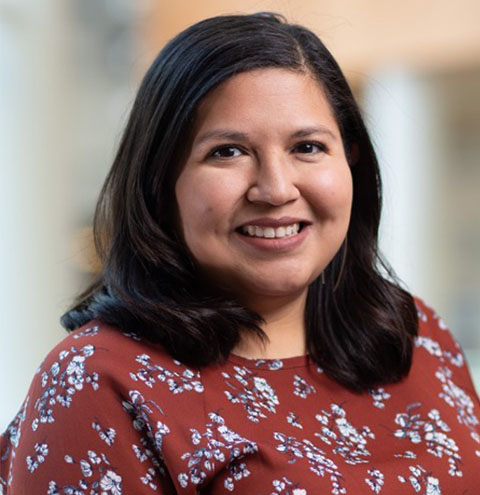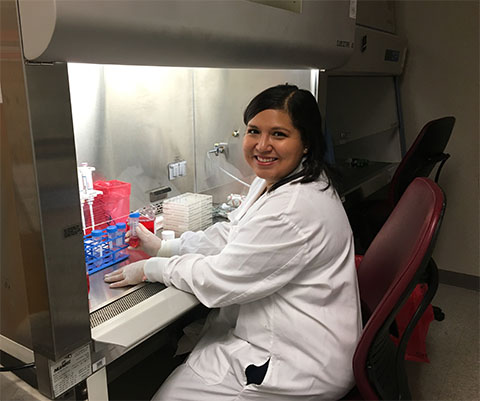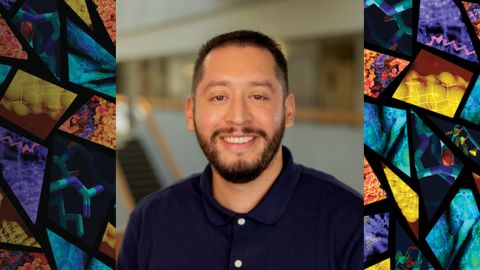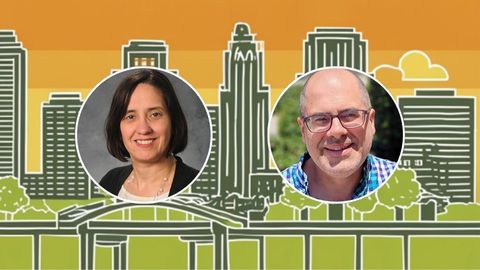A scientist's journey through disability, grad school, and beyond
Five years into graduate school, Crystal Mendoza thought she had it all figured out. She’d been the first in her family to attend college, completed the applications on her own, moved away and battled homesickness. Finally, she was established in a lab and studying the science she loved.
Physically, however, she was struggling. At the age of 24, she was experiencing mental fog and mysterious, debilitating pain that made it impossible to work at the bench. Eventually, she got a diagnosis that put a name to her symptoms: fibromyalgia, a musculoskeletal disorder that causes chronic pain and fatigue.

While coming to terms with her disability, Mendoza wondered if she should stay in grad school, a place she had worked so hard to be but that no longer felt sustainable? In the end, she decided she needed a long break to prioritize her mind and body.
Seven and a half years and two labs after she began her Ph.D., Mendoza graduated with a degree in virology and gene therapy, and a love for scientific research that had started in high school and never wavered.
Charting a path
Mendoza grew up in El Paso, Texas, after her parents and their families immigrated from Mexico.
“I'm first-generation American — not a whole lot of generational wealth,” she said. “But the thing that is very nice about first-generation families is that they kind of expect you to go to college, because that's part of the American dream.”
By the end of high school, she was well on her way, with an associate’s degree and most of her undergraduate credits earned through a local community college.
Mendoza also began working in a virology research lab during high school. A teacher pursuing a Ph.D. at the University of Texas at El Paso told her about a program that brought high school students into the university’s labs. Mendoza was learning about HIV and the AIDs epidemic in health class, and virology turned out to be a lasting interest. She joined Manuel Llano’s lab, working on HIV molecular virology during her last year of high school and two years of college.
Although she had the credits to finish her bachelor’s degree in just one year, Mendoza decided to stay on for an extra year to figure out her next steps. With Llano providing encouragement that graduate school could be an option, she began applying to programs in her senior year.
Graduate school applications were all uncharted territory. She remembers flying on planes and calling taxis by herself for the first time, and the shock of visiting Minnesota in 20-degree weather when it was usually above 80 in Texas. While traveling, she was also surprised to see herself as a minority in the United States. In her hometown, Mendoza was one of many Hispanic residents, but in the schools she visited, there weren’t many people who looked like her.

A surprise diagnosis
After 20 years in El Paso, Mendoza was ready for something different. She was excited to make the big move to Rochester, Minnesota, and start her Ph.D. at the Mayo Clinic Graduate School of Biomedical Sciences. But, for the first six months of the program, she was also homesick, really homesick. And while she loved working in the lab, Mendoza found her classes more challenging than expected. She had always been a high achiever, and it took time to accept that it was okay not to ace every subject.
Her fibromyalgia diagnosis came months after the onset of her symptoms, which had made keeping up with her lab schedule unsustainable. Experiments came to a halt, and she realized that she needed to take a medical leave, rest and reset, before she could come back to the program.
Mendoza wrote about this experience in an article titled “Advice from an Ex-perfectionist: On Being a Graduate Student and Living with Chronic Pain.” She reflected on how her disability upended her life as a graduate student and the strategies she used to manage her physical and mental well-being.
“For me, I think it was bringing awareness to the fact that it can happen to anybody,” Mendoza said about her impetus for writing. “And that's, I think, really scary. I think the thing that I took away most from it is that grad school and science are not always super open to having people with disabilities.”
People sometimes thought she was faking her symptoms, which Mendoza described as “tough to live with.” At the same time, she stressed that she was able to overcome some aspects of her illness. There are ways to work through it, she said, and she listens to her body about when it’s better to rest than to push through.
Whether to finish her Ph.D. was a fraught decision, but in the end, her love of science won out. And she found support. She switched mentors in the fourth year of her program, finding a principal investigator who better understood her condition. She had a close lab mate who also dealt with chronic pain, and her partner reminded her to keep up with healthy habits even when it felt overwhelming.
“Look for support,” she said, “and try to find people that have similar stories to you that you can lean on for that support.”

Bringing each other up
“Advice from an Ex-Perfectionist” was published by the Society for Advancement of Chicanos/Hispanics & Native Americans in Science, on their STEM + Culture Chronicle on Medium. Mendoza has been a SACNAS member for over a decade. She joined in college when it seemed like her whole biomedical building was involved, and she helped found a chapter at the Mayo Clinic.
Last year Mendoza attended the Linton–Poodry SACNAS Leadership Institute program, designed to help early career professionals reflect on how they want to lead. She said she thought about how to lead with empathy and how to speak to people in an accessible way. More recently, she was also excited about taking on mentees through the society and helping to guide their next steps.
“I learned it the hard way, and it doesn't need to be hard for everybody,” Mendoza said, thinking back to her preparations for graduate school. “If you're coming from a disadvantaged background, why not give yourself the leg up? Why not pair yourself with somebody that has the experience, and let's bring them forward and continually bring each other up.”
On the theme of making science more accessible, Mendoza also cares deeply about science communication. She remembers the frustration of trying to explain an experiment to her parents, then getting lost in jargon that was second nature to her but sounded like a foreign language to them. She realized she needed to put more effort into her communication if she wanted to bridge the gap between people with and without scientific training. During the COVID-19 pandemic, Mendoza saw this disconnect at the national level.
“Sometimes scientists are really keen to divulge the information, not to necessarily listen to people's concerns or act in terms of empathy,” she said.
While tiring, she said, being patient and willing to meet people at their level of understanding is essential to get your point across.
When the opportunity arose, Mendoza joined the American Society for Biochemistry and Molecular Biology’s Science Outreach and Communication Committee. Serving on the science communication subcommittee, she has now led the Art of Science Communication course several times. This course helps scientists better explain their research to general audiences.
For the 2024 ASBMB Annual Meeting in San Antonio, Mendoza was part of a team that whittled the eight-week course into a three-hour workshop. They repackaged major themes of the course such as storytelling and reducing jargon to help participants make their abstracts more accessible. Condensing the course was a challenge, but she said the team got great feedback and suggestions on how to improve for next year.
Looking forward, Mendoza hopes to continue her efforts in science outreach and communication, while working in the lab to create vaccines for a variety of illnesses. And she will keep supporting the next generation of scientists, spinning her hard-won knowledge into advice and anecdotes to help push them to wherever they want to go.
Enjoy reading ASBMB Today?
Become a member to receive the print edition four times a year and the digital edition monthly.
Learn moreGet the latest from ASBMB Today
Enter your email address, and we’ll send you a weekly email with recent articles, interviews and more.
Latest in People
People highlights or most popular articles

2025 ASBMB election results
Learn about the new president, secretary, Council members and committee members.

2025 PROLAB awardees announced
Seven early-career scientists receive grants to advance their research by working in North American labs.

Yu receives early career research award
He will receive $35,000 to fund his research on the proteotype and cell signaling.

Neurobiology of stress and substance use
MOSAIC scholar and proud Latino, Bryan Cruz of Scripps Research Institute studies the neurochemical origins of PTSD-related alcohol use using a multidisciplinary approach.

Hargrove recognized for leadership
He is among more than 50 individuals from the Iowa State University College of Liberal Arts and Sciences to receive recognition for their departmental dedication and contributions.

Teach, learn & transform biochemistry education
Meet the co-chairs of the 2025 ASBMB meeting on reimagining undergraduate education in the molecular life sciences to be held July 24–27, 2025 in St. Paul, Minnesota.

